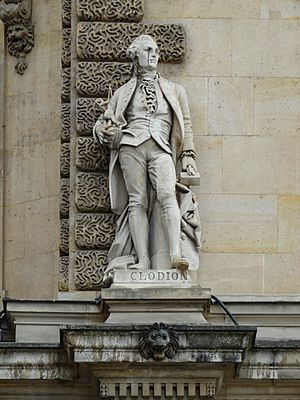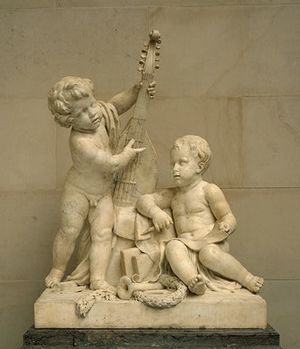Claude Michel facts for kids
Quick facts for kids
Claude Michel
|
|
|---|---|

Statue of Clodion by Vital Gabriel Dubray
|
|
| Born | December 20, 1738 |
| Died | March 29, 1814 (aged 75) |
| Nationality | French |
| Known for | Sculpting, mainly terracotta |
| Style | Rococo |
| Spouse(s) | Flore Pajou (1781–1794) |
Claude Michel (born December 20, 1738 – died March 29, 1814) was a talented French sculptor. He was famously known as Clodion. He worked in the Rococo style, which was popular for its fancy and playful designs. Clodion was especially good at making sculptures from terracotta, a type of baked clay.
Contents
Clodion's Story
Clodion was born in Nancy, France. His mother, Anne Adam, came from a family of sculptors. Her brothers, Lambert-Sigisbert Adam and Francois Gaspard Adam, were also sculptors.
In 1755, Clodion moved to Paris. He began to learn sculpting from his uncle, Lambert-Sigisbert Adam. After four years, when his uncle passed away, Clodion became a student of another famous sculptor, Jean-Baptiste Pigalle.
Clodion was a very promising student. In 1759, he won a big award for sculpture at the Académie Royale. In 1761, he won another award for his studies of models. The next year, in 1762, he traveled to Rome, Italy. He worked there a lot between 1767 and 1771, creating many sculptures.
Even though Catherine II of Russia wanted him to come to St. Petersburg, Russia, Clodion decided to return to Paris. Many important people and groups hired him to create art. His sculptures were often shown in art exhibitions called the Salon. In 1782, he married Catherine Flore, whose father, Augustin Pajou, was also a sculptor.
During the French Revolution, Clodion moved back to Nancy in 1792. He stayed there until 1798, spending his time decorating houses. Clodion passed away in Paris in 1814.
Clodion's Famous Sculptures
Clodion created many beautiful artworks. Some of his well-known sculptures include a statue of Montesquieu, a piece called Dying Cleopatra, and a special fireplace decoration now in the Victoria and Albert Museum in London.
His sculpture from 1788, called Dance of Time, can be seen at the Frick Collection in New York. Another famous work is "The Intoxication of Wine." One of his last groups of sculptures, made in 1810, showed Homer being sent away by fishermen.
Where to See Clodion's Art
You can find Clodion's sculptures in many public art collections around the world. Here are some of them:
- Art Institute of Chicago (USA)
- Bowes Museum (County Durham, UK)
- Carnegie Museum of Art (Pittsburgh, Pennsylvania, USA)
- Cleveland Museum of Art (USA)
- Courtauld Institute of Art (London, UK)
- Currier Museum of Art (New Hampshire, USA)
- Detroit Institute of Arts (USA)
- Fine Arts Museums of San Francisco (USA)
- Getty Museum (Los Angeles, USA)
- Honolulu Museum of Art (USA)
- Kimbell Art Museum (Fort Worth, Texas, USA)
- Kunstindeks Danmark (Denmark)
- Louvre (Paris, France)
- Metropolitan Museum of Art (USA)
- Musée Cognacq-Jay (Paris, France)
- Museum of Fine Arts, Boston (USA)
- Musée des beaux-arts de Bordeaux (France)
- Museum Boijmans Van Beuningen (Rotterdam, Netherlands)
- National Museum of Art (Cluj-Napoca, Romania)
- National Gallery of Armenia (Armenia)
- National Gallery of Art (Washington D.C., USA)
- Nationalmuseum, Stockholm (Sweden)
- Norton Simon Museum (Pasadena, California, USA)
- Philadelphia Museum of Art (USA)
Images for kids
-
'Faun Family', terracotta relief by Claude Michel, c. 1785, National Gallery of Art, Washington, D. C.jpg
Faun Family, a terracotta relief by Claude Michel, made around 1785. It is at the National Gallery of Art in Washington, D.C.
See also
 In Spanish: Claude Michel para niños
In Spanish: Claude Michel para niños


